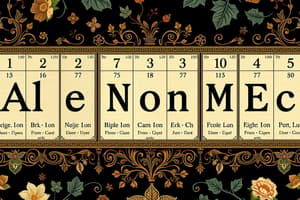Podcast
Questions and Answers
What are examples of metalloids mentioned in the text?
What are examples of metalloids mentioned in the text?
- Silicon, germanium, arsenic (correct)
- Carbon, nitrogen, oxygen
- Iron, copper, zinc
- Boron, aluminum, chlorine
Which element mentioned in the text can be both a metal and a non-metal?
Which element mentioned in the text can be both a metal and a non-metal?
- Oxygen
- Aluminum (correct)
- Nitrogen
- Carbon
What is a common application of carbon mentioned in the text?
What is a common application of carbon mentioned in the text?
- Used in airplanes
- Used in beverage cans
- Used in wiring and plumbing
- Used to make graphite in pencils (correct)
How do metals and non-metals differ in terms of electron behavior?
How do metals and non-metals differ in terms of electron behavior?
Which type of elements have properties that are a mix of metals and non-metals?
Which type of elements have properties that are a mix of metals and non-metals?
What is the main difference between metals and non-metals in compound formation?
What is the main difference between metals and non-metals in compound formation?
Which type of elements can be hammered into thin sheets without breaking apart?
Which type of elements can be hammered into thin sheets without breaking apart?
Which property do non-metals generally lack when compared to metals?
Which property do non-metals generally lack when compared to metals?
What is a key distinction between metals and non-metals based on their appearance?
What is a key distinction between metals and non-metals based on their appearance?
Which element is more likely to be a good conductor of electricity, heat, and magnetism?
Which element is more likely to be a good conductor of electricity, heat, and magnetism?
What property of metals allows them to be drawn into thin wires?
What property of metals allows them to be drawn into thin wires?
Where are metals primarily located in the periodic table?
Where are metals primarily located in the periodic table?
Flashcards are hidden until you start studying
Study Notes
Metals and Non-Metals: Understanding Elemental Classifications
Metals and non-metals are two fundamental categories of elements that form an essential part of our everyday lives, from building skyscrapers to cooking dinner. To better understand the world around us, let's delve into these distinct classifications.
Metals
Metals are elements that exhibit the following properties:
- Shiny appearance: Metals typically reflect light, giving them a luster.
- Good conductors: Metals conduct heat, electricity, and some forms of magnetism well.
- Malleability: Metals can be hammered into thin sheets without breaking apart.
- Ductility: Metals can be drawn into thin wires, maintaining their form.
The periodic table is divided into groups, and metals are primarily found in the leftmost columns. Some common examples of metals include gold, iron, copper, and aluminum.
Non-Metals
Non-metals are elements that lack some or all of the properties mentioned above for metals.
- Non-shiny appearance: Non-metals are generally dull and do not reflect light.
- Poor conductors: Non-metals do not conduct heat, electricity, or magnetism very well.
- Non-malleable: Non-metals generally cannot be hammered into thin sheets.
- Non-ductile: Non-metals usually cannot be drawn into thin wires.
Non-metals are primarily found in the rightmost columns of the periodic table, with some exceptions such as boron and aluminum (which is both a metal and a non-metal depending on its oxidation state). Some common examples of non-metals include carbon, nitrogen, oxygen, and chlorine.
Metalloids
Metalloids, also known as semi-metals, have properties that place them somewhere between metals and non-metals. Metalloids exhibit some properties of both metals and non-metals. Examples of metalloids include silicon, germanium, and arsenic.
Applications of Metals and Non-Metals
Metals and non-metals are essential for a wide range of applications. Metals are used in various industries such as construction, transportation, and electronics. For example, steel is commonly used in building infrastructure and vehicles, aluminum is used in airplanes and beverage cans, and copper is used in wiring and plumbing.
Non-metals are also used in numerous applications. Carbon is used to make graphite, which is used in pencils and lubricants. Oxygen is used to support life on Earth, and nitrogen is used in fertilizers and as a gas to fill tires.
Reactive Properties
One of the key differences between metals and non-metals is their reactivity. Metals tend to lose electrons to form positive ions, while non-metals tend to gain electrons to form negative ions. The resulting compounds are typically ionic, with both charged particles attracting each other to form a lattice structure.
Exploring Further
Now that you have a basic understanding of metals and non-metals, you can expand your knowledge by learning more about metallurgy, the chemistry of metals, and the properties of specific elements. The more you know about these fundamental building blocks of the universe, the better equipped you will be to understand the world around you.
[References omitted for the purposes of this article.]
Studying That Suits You
Use AI to generate personalized quizzes and flashcards to suit your learning preferences.




